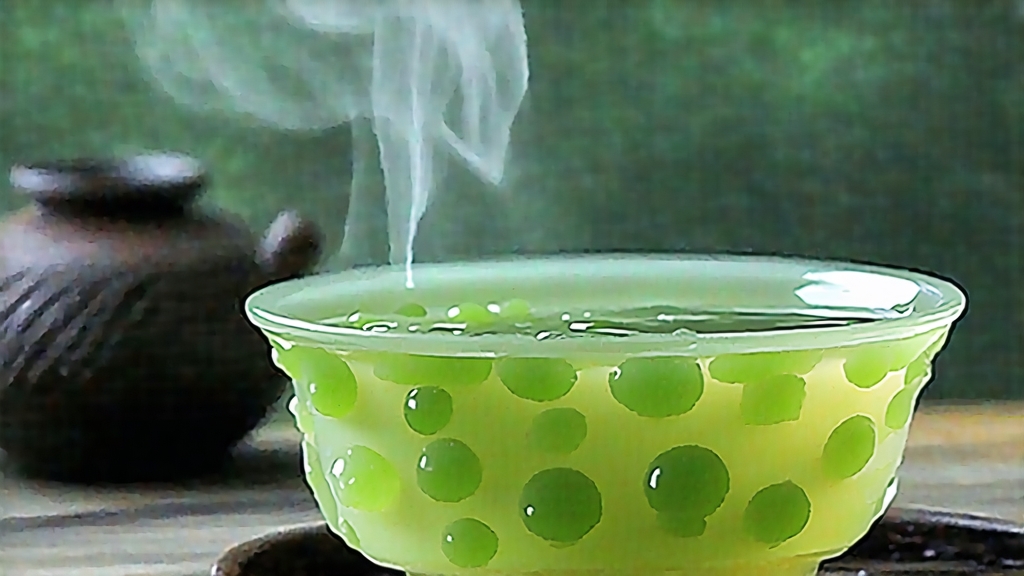
Tie Guan Yin, literally “Iron Goddess of Mercy,” is the most celebrated style of Chinese oolong, a tea that sits poetically between green freshness and black depth. First created in the early eighteenth century in Anxi County, Fujian Province, its legend is inseparable from local devotion to Guan Yin, the Bodhisattva of Compassion. A humble farmer, so the story goes, was led by the goddess to a stunted shrub hidden in a crevice of iron-rich soil; after nursing it back to health he discovered leaves that infused into a liquor so fragrant it seemed heaven-sent. Whether myth or marketing, the tale captures the reverence Anxi farmers still feel for this cultivar, and explains why every spring they perform incense-offering rituals before the first pluck.
Botanically, Tie Guan Yin is a genetically distinct strain of Camellia sinensis var. sinensis, identified by its thick, serrated, jade-dark leaves and a signature lateral vein that curves like a tiny talon. Over three centuries, clonal selection has produced sub-cultivars—Red Heart Tie Guan Yin, Green Heart, and the newer “Wedding fragrance”—each differing in leaf chemistry and aromatics, yet all legally protected under China’s Geographic Indication system as “Anxi Tie Guan Yin.” No other county may sell tea under this name, a measure that safeguards both terroir and centuries of craft.
The craft itself is a choreography of wither, bruise, oxidize, fix, roll, bake, and rest, repeated across thirty-six hours with the precision of a Swiss watch. Picking begins at dawn when two leaves and a bud still hold overnight dew; the goal is a standard known as “small open face,” where the top leaf is just unfurling. Sun-withering lasts only twenty minutes—long enough to soften cell walls yet short enough to lock in bright green chlorophyll. Indoor withering on bamboo trays follows, where the leaf is gently tossed every half hour, coaxing water outward while edges bruise against one another. This controlled damage triggers enzymatic oxidation at the rim, leaving the center emerald; the contrast is what oolong artisans call “green leaf with red fringe.”
Oxidation is arrested in an electric drum heated to 230 °C for four minutes, a step called shaqing or “killing the green,” which fixes the 30–40 percent oxidation that defines Tie Guan Yin. While green tea skips oxidation and black tea completes it, oolong dwells in the paradoxical middle, and Tie Guan Yin hovers at the lower end, explaining its jade infusion and orchid nose. Next comes rolling, first mechanically then by hand in linen bundles, twisting leaves into the compact, pellet-like “dragonfly head” shape that resists breakage and traps aroma. A low-temperature bake at 70 °C for six hours reduces moisture to 4 percent, after which the tea is left to “rest” for at least thirty days so residual heat dissipates and flavor polymers stabilize. Only then is it judged worthy of market.
Modern Anxi has also pioneered a “light fermentation” or “modern fragrance” style that shortens oxidation to 15 percent and omits the final charcoal bake. The result is a tea that sparkles with snap-pea sweetness and magnolia top notes, but purists argue it lacks the throaty “yin yun” or lingering rhyme of the traditional roast. To satisfy both camps, master Chen Qinglong charcoal-bakes a reserve lot over three consecutive springs, using longan-wood embers at 60 °C for twelve hours each season. The triple baking deepens color to golden jade, layers in toasted almond and warm milk, and allows the tea to age gracefully for decades, acquiring a patina of dried apricot and camphor reminiscent of old sheng pu-erh.
Water is the silent ingredient. In Anxi, well water drawn from granite aquifers is naturally soft at 45 ppm TDS; when replicated abroad, filtered water with 30–50 ppm and a neutral pH of 7 best preserves the tea’s subtle acids. Begin by pre-warming a 120 ml gaiwan with 95 °C water; this “awakens” the porcelain and prevents thermal shock. Use 7 g of tea—about two heaping teaspoons—for a 1:17 leaf-to-water ratio. The first infusion, lasting only fifteen seconds, is a rinse to open the pellets and is discarded. Subsequent steeps progress from twenty-five seconds to two minutes, with the fourth infusion often considered the apex